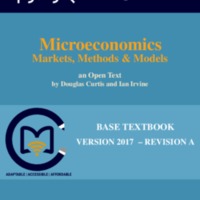Microeconomics: Markets, Methods and Models
Dublin Core
Subject
Description
Microeconomics: Markets, Methods and Models provides a concise, yet complete, coverage of introductory microeconomic theory, application and policy in a Canadian and global environment. Our beginning is orthodox: we explain and develop the standard tools of analysis in the discipline. Economic policy is about the well-being of the economy’s participants, and economic theory should inform economic policy. So we investigate the meaning of ‘well-being’ in the context of an efficient use of the economy’s resources early in the text.
We next develop an understanding of individual optimizing behaviour. This behaviour in turn is used to link household decisions on savings with firms’ decisions on production, expansion and investment. A natural progression is to explain production and cost structures. From the individual level of household and firm decision making, the text then explores behaviour in a variety of different market structures.
Markets for the inputs in the productive process – capital and labour – are a natural component of firm-level decisions. But education and human capital are omnipresent concepts and concerns in the modern economy, so we devote a complete chapter to them. The book then examines the role of a major and important non-market player in the economy – the government, and progresses to develop the key elements in the modern theory of international trade.
Opportunity cost, a global economy and behavioural responses to incentives are the dominant themes.
We next develop an understanding of individual optimizing behaviour. This behaviour in turn is used to link household decisions on savings with firms’ decisions on production, expansion and investment. A natural progression is to explain production and cost structures. From the individual level of household and firm decision making, the text then explores behaviour in a variety of different market structures.
Markets for the inputs in the productive process – capital and labour – are a natural component of firm-level decisions. But education and human capital are omnipresent concepts and concerns in the modern economy, so we devote a complete chapter to them. The book then examines the role of a major and important non-market player in the economy – the government, and progresses to develop the key elements in the modern theory of international trade.
Opportunity cost, a global economy and behavioural responses to incentives are the dominant themes.
Publisher
Contributor
Cut Rita Zahara
Rights
Creative Commons
Type
Files
Collection
Citation
Doug Curtis and Ian Irvine, “Microeconomics: Markets, Methods and Models,” Open Educational Resources (OER) , accessed December 9, 2025, https://oer.uinsyahada.ac.id/items/show/639.


